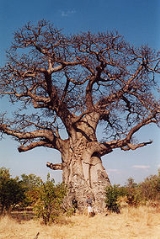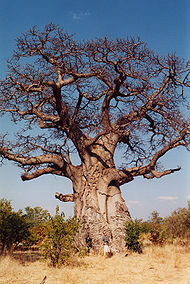
Deux Balés National Park
Encyclopedia
Deux Balés National Park is a national park
located in central eastern Burkina Faso
. It is within Mouhoun Province
just west of the Black Volta River and at an elevation of 235-310m.
. In 1967, while part of the newly independent Republic of Upper Volta
, the area was given the name of a National Park and referred to as 'parc national des Deux Balés'. However, there is still no law establishing it as a national park.
Poaching
occurs in the park, and in 1968 there was a considerable reduction of large mammal populations by the 'Service de l'Elevage'.
In 1989, the International Union for Conservation of Nature recommended that "The legal status of Deux Balés National Park should be reviewed, in light of agricultural and mining activities which conflict with the integrity of its elephant populations".
By 2001, Burkina Faso was sheltering the largest number of elephant
s in West Africa, and Deux Balés (together with Baporo Forest) was home to roughly four hundred of them.
plain
, with outcrop
s of rock and lateritic
plateau
x. It lies at an altitude
of 235 to 310 metres.
 The Park has been called "an area of about 200000 acres (809.4 km²) of bushland
The Park has been called "an area of about 200000 acres (809.4 km²) of bushland
and aging baobab
trees". The vegetation comprises Sudano-Zambezian savanna
with a carpet of grasses, and trees such as Anogeissus leiocarpus
, Isoberlinia doka
and Terminalia laxiflora. There is gallery forest on the riverbanks.
Mammals include hippopotamus
Hippopotamus amphibius, buffalo
Syncerus caffer, elephant
Loxodonta africana, crocodile
Crocodylus sp. and antelope
s, although the diversity of fauna has been reported as being reduced.
In Antelopes: Global Survey And Regional Action Plans (1990), Rod East stated the view that the long-term survival of Burkina Faso's antelope populations would depend on developing rational wildlife utilization schemes in areas such as Deux Balés, recognizing the importance of bushmeat, and that giving legal protection to the antelope there would achieve little without other improvements in management.
The forests lying along some one hundred kilometres of the banks of the Black Volta River are protected within the Deux Balés.
National park
A national park is a reserve of natural, semi-natural, or developed land that a sovereign state declares or owns. Although individual nations designate their own national parks differently A national park is a reserve of natural, semi-natural, or developed land that a sovereign state declares or...
located in central eastern Burkina Faso
Burkina Faso
Burkina Faso – also known by its short-form name Burkina – is a landlocked country in west Africa. It is surrounded by six countries: Mali to the north, Niger to the east, Benin to the southeast, Togo and Ghana to the south, and Côte d'Ivoire to the southwest.Its size is with an estimated...
. It is within Mouhoun Province
Mouhoun Province
Mouhoun is one of the 45 provinces of Burkina Faso and is in Boucle du Mouhoun Region. The capital of Mouhoun is Dédougou.Most people in the province live in rural areas; 260,295 Burkinabé live in the countryside with only 37,793 people residing in urban areas...
just west of the Black Volta River and at an elevation of 235-310m.
History
Deux Balés National Park was first established in 1937 as the forêts classées des Deux Balés ('the Deux Balés Classified Forests') with an area of 610 square kilometres. At that time, it was part of French West AfricaFrench West Africa
French West Africa was a federation of eight French colonial territories in Africa: Mauritania, Senegal, French Sudan , French Guinea , Côte d'Ivoire , Upper Volta , Dahomey and Niger...
. In 1967, while part of the newly independent Republic of Upper Volta
Republic of Upper Volta
The Republic of Upper Volta was established on December 11, 1958, as a self-governing colony within the French Community. Before attaining autonomy it had been French Upper Volta and part of the French Union. On August 5, 1960 it attained full independence from France.Thomas Sankara came to power...
, the area was given the name of a National Park and referred to as 'parc national des Deux Balés'. However, there is still no law establishing it as a national park.
Poaching
Poaching
Poaching is the illegal taking of wild plants or animals contrary to local and international conservation and wildlife management laws. Violations of hunting laws and regulations are normally punishable by law and, collectively, such violations are known as poaching.It may be illegal and in...
occurs in the park, and in 1968 there was a considerable reduction of large mammal populations by the 'Service de l'Elevage'.
In 1989, the International Union for Conservation of Nature recommended that "The legal status of Deux Balés National Park should be reviewed, in light of agricultural and mining activities which conflict with the integrity of its elephant populations".
By 2001, Burkina Faso was sheltering the largest number of elephant
Elephant
Elephants are large land mammals in two extant genera of the family Elephantidae: Elephas and Loxodonta, with the third genus Mammuthus extinct...
s in West Africa, and Deux Balés (together with Baporo Forest) was home to roughly four hundred of them.
Physical features
The National Park is part of an undulating graniticGranite
Granite is a common and widely occurring type of intrusive, felsic, igneous rock. Granite usually has a medium- to coarse-grained texture. Occasionally some individual crystals are larger than the groundmass, in which case the texture is known as porphyritic. A granitic rock with a porphyritic...
plain
Plain
In geography, a plain is land with relatively low relief, that is flat or gently rolling. Prairies and steppes are types of plains, and the archetype for a plain is often thought of as a grassland, but plains in their natural state may also be covered in shrublands, woodland and forest, or...
, with outcrop
Outcrop
An outcrop is a visible exposure of bedrock or ancient superficial deposits on the surface of the Earth. -Features:Outcrops do not cover the majority of the Earth's land surface because in most places the bedrock or superficial deposits are covered by a mantle of soil and vegetation and cannot be...
s of rock and lateritic
Laterite
Laterites are soil types rich in iron and aluminium, formed in hot and wet tropical areas. Nearly all laterites are rusty-red because of iron oxides. They develop by intensive and long-lasting weathering of the underlying parent rock...
plateau
Plateau
In geology and earth science, a plateau , also called a high plain or tableland, is an area of highland, usually consisting of relatively flat terrain. A highly eroded plateau is called a dissected plateau...
x. It lies at an altitude
Altitude
Altitude or height is defined based on the context in which it is used . As a general definition, altitude is a distance measurement, usually in the vertical or "up" direction, between a reference datum and a point or object. The reference datum also often varies according to the context...
of 235 to 310 metres.
Flora and fauna

Bushland
Bushland is any area in Australia that is predominantly indigenous flora and fauna.Bushland is the term commonly used by conservation protection groups and other environmental groups as a blanket term for natural vegetation, which may cover any kind of habitat from open shrubby country with few...
and aging baobab
Baobab
Adansonia is a genus of eight species of tree, six native to Madagascar, one native to mainland Africa and the Arabian Peninsula and one to Australia. The mainland African species also occurs on Madagascar, but it is not a native of that island....
trees". The vegetation comprises Sudano-Zambezian savanna
Savanna
A savanna, or savannah, is a grassland ecosystem characterized by the trees being sufficiently small or widely spaced so that the canopy does not close. The open canopy allows sufficient light to reach the ground to support an unbroken herbaceous layer consisting primarily of C4 grasses.Some...
with a carpet of grasses, and trees such as Anogeissus leiocarpus
Anogeissus leiocarpus
Anogeissus leiocarpa is a tall evergreen tree native to savannas of Tropical Africa. It is the sole West African species of the genus Anogeissus, a genus otherwise distributed from tropical central and east Africa through tropical Southeast Asia. A...
, Isoberlinia doka
Isoberlinia doka
Isoberlinia doka is a hardwood tree native to African tropical savannas and Guinean forest-savanna mosaic dry forests where it can form single species stands. The tree is exploited for its economic value as a commercial timber. The leaves and shoots of the tree dominate the diet of the Giant...
and Terminalia laxiflora. There is gallery forest on the riverbanks.
Mammals include hippopotamus
Hippopotamus
The hippopotamus , or hippo, from the ancient Greek for "river horse" , is a large, mostly herbivorous mammal in sub-Saharan Africa, and one of only two extant species in the family Hippopotamidae After the elephant and rhinoceros, the hippopotamus is the third largest land mammal and the heaviest...
Hippopotamus amphibius, buffalo
African Buffalo
The African buffalo, affalo, nyati, Mbogo or Cape buffalo is a large African bovine. It is not closely related to the slightly larger wild Asian water buffalo, but its ancestry remains unclear...
Syncerus caffer, elephant
Elephant
Elephants are large land mammals in two extant genera of the family Elephantidae: Elephas and Loxodonta, with the third genus Mammuthus extinct...
Loxodonta africana, crocodile
Crocodile
A crocodile is any species belonging to the family Crocodylidae . The term can also be used more loosely to include all extant members of the order Crocodilia: i.e...
Crocodylus sp. and antelope
Antelope
Antelope is a term referring to many even-toed ungulate species indigenous to various regions in Africa and Eurasia. Antelopes comprise a miscellaneous group within the family Bovidae, encompassing those old-world species that are neither cattle, sheep, buffalo, bison, nor goats...
s, although the diversity of fauna has been reported as being reduced.
In Antelopes: Global Survey And Regional Action Plans (1990), Rod East stated the view that the long-term survival of Burkina Faso's antelope populations would depend on developing rational wildlife utilization schemes in areas such as Deux Balés, recognizing the importance of bushmeat, and that giving legal protection to the antelope there would achieve little without other improvements in management.
The forests lying along some one hundred kilometres of the banks of the Black Volta River are protected within the Deux Balés.

